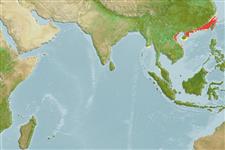>
Clupeiformes (Herrings) >
Dorosomatidae (Gizzard shads and sardinellas)
Etymology: Tenualosa: Latin, tenuis = thin + Latin, alausa = a fish cited by Ausonius and Latin, halec = pickle, dealing with the Greek word hals = salt; it is also the old Saxon name for shad = "alli" ; 1591 (Ref. 45335).
More on author: Richardson.
Environment: milieu / climate zone / depth range / distribution range
Ecología
marino; agua dulce; salobre; anadromo (Ref. 51243); rango de profundidad 0 - 50 m (Ref. 188). Tropical; 31°N - 5°N, 95°E - 123°E (Ref. 188)
Northwest Pacific: China and possibly southward into South China Sea, but records uncertain. Eastern Indian Ocean: two specimens collected from Phuket Island, Andaman Sea. The species thus overlaps Tenualosa toli in range.
Length at first maturity / Tamaño / Peso / Age
Maturity: Lm 47.5, range 44 - 51 cm
Max length : 61.6 cm TL macho / no sexado; (Ref. 45563); common length : 40.0 cm TL macho / no sexado; (Ref. 27773); peso máximo publicado: 5.0 kg (Ref. 47439); edad máxima reportada: 8 años (Ref. 45563)
Espinas dorsales (total): 3; Radios blandos dorsales (total): 14-15; Espinas anales 2; Radios blandos anales: 16 - 18; Vértebra: 44 - 45. Belly with 29 to 34 scutes. Head large; a median notch in upper jaw, which distinguishes it from other similar clupeids, except Hilsa kelee; with a well developed sebaceous eyelids. Gill rakers fine and numerous, each raker with scattered asperities. Caudal fin deeply forked with minute scales. A dark blotch behind gill opening and a series of spots along flank. Color: Metallic blue-green back that lightens to silver along the sides (Ref. 45563).
Schooling in coastal waters and ascending rivers to breed. Adults are found near the surface at sea while larvae and juveniles spend the first two years of their life in river tide pools and estuaries (Ref. 57990). Feed on planktonic crustaceans like cyclopoids and other copepods, and rotifers (Ref. 45563).
Ascend rivers to breed (Ref. 45563). After spawning, the adults go back to the sea while the larvae stay in river mouths during their first year. At the beginning of their second year, the juveniles swim to the sea (Ref. 45563).
Whitehead, P.J.P., 1985. FAO Species Catalogue. Vol. 7. Clupeoid fishes of the world (suborder Clupeoidei). An annotated and illustrated catalogue of the herrings, sardines, pilchards, sprats, shads, anchovies and wolf-herrings. FAO Fish. Synop. 125(7/1):1-303. Rome: FAO. (Ref. 188)
IUCN Red List Status (Ref. 130435)
Threat to humans
Harmless
Human uses
Pesquerías: escaso valor comercial
Más información
ReferenciasAcuiculturaPerfil de acuiculturaRazasGenéticaElectrophoresesheritabilidadEnfermedadesProcesamientoNutrientsMass conversion
ColaboradoresImágenesStamps, Coins Misc.SonidosCiguateraVelocidadTipo de nataciónSuperficie branquialOtolitosCerebrosVisión
Herramientas
Special reports
Download XML
Fuentes de Internet
Estimates based on models
Preferred temperature (Ref.
123201): 22.8 - 26.6, mean 25.2 °C (based on 90 cells).
Phylogenetic diversity index (Ref.
82804): PD
50 = 0.5312 [Uniqueness, from 0.5 = low to 2.0 = high].
Bayesian length-weight: a=0.01122 (0.00689 - 0.01827), b=3.04 (2.90 - 3.18), in cm total length, based on LWR estimates for this species & (Sub)family-body (Ref.
93245).
Nivel trófico (Ref.
69278): 3.2 ±0.29 se; based on food items.
Generation time: 3.8 ( na - na) years. Estimated as median ln(3)/K based on 2
growth studies.
Resiliencia (Ref.
120179): Medio, población duplicada en un tiempo mínimo de 1.4-4.4 años (tm=3; tmax=8; K=0.25-0.29; Fec = 1,070,000).
Fishing Vulnerability (Ref.
59153): Low to moderate vulnerability (34 of 100).
